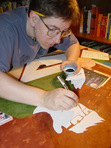cephalopods and the art of small things
Yesterday I read an article titled “Cephalopods Adapt By Editing Their Genes” and that reminded me of the value in periodically examining our own assumptions, our own stories, our own worldview and being willing to rearrange our own mental furniture.
Perhaps adapting or editing the stories you tell yourself is the human equivalent of editing genetic code as a cephalopod?
Reexamining stories, assumptions and the kinds of questions you ask are also keys to creative thinking.
I’ve noticed that the kinds of questions a person asks makes a difference in creative thinking. For example asking “How can I include at least one fresh vegetable in this meal?” elicits a more exciting creative response than the question “How can I eat more healthfully?”
Likewise asking the small question “What art medium/technique would be most fun to use to depict my favorite food?” provokes a more joyous creative response than the question “What fine art can I make on a universal theme?”
Most days I wake up thinking “what small thought can I think about or re-think about today?”
So today’s small things I’m thinking about are pictured here:
[image error]
By list:
“Cephalopods adapt by editing their genes” http://www.columbian.com/news/2017/apr/13/cephalopods-adapt-by-editing-their-genes/
“The Drunken Botanist” by Amy Stewart
“Creative, Inc.” by Meg Mateo Ilasco & Joy Cho
A postcard of “Chaco Culture” a National Historical Park in New Mexico
My coffee cup and a glass marble.
And to put the concept in this blog post yet another way: Here is a page from my book “Dr. Bob’s Emotional Repair Program First Aid Kit” https://store.bookbaby.com/book/dr-bobs-emotional-repair-program-first-aid-kit
[image error]




